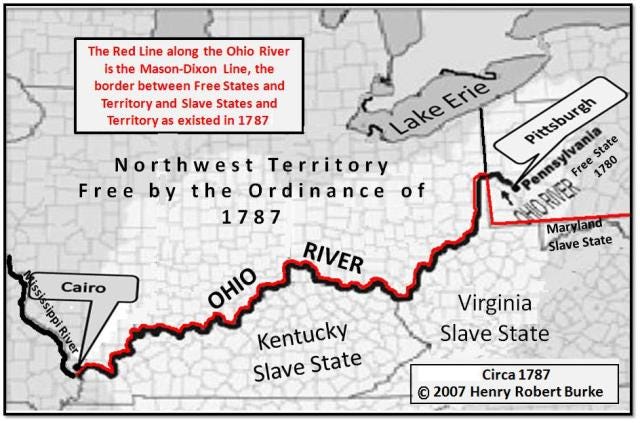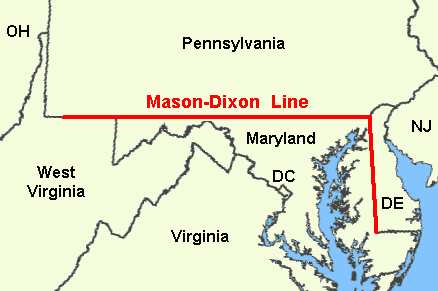Why North of the Ohio River was Slavery-Free
The reasons weren't so much moral as economic. Go figure.
The Ohio River was America’s longest slavery border. It shaped the culture and institutions of the entire region before the Civil War, and into the present day. As I continue expanding my body of work here, I’ll show you what I mean.
First, a note about slave borders. We usually think of the Mason-Dixon as the dividing line between slave- and free-states, but it wasn’t intended for that use when it was surveyed to settle a colonial land dispute. The original was only 233 miles long and didn’t even cover the entire southern border of Pennsylvania because parts of it weren’t involved in the land dispute. The Missouri Compromise of 1820 made use of the old survey in defining free states.
The Ohio River (981 miles) is significantly longer, and the 1787 Northwest Ordinance banned slavery on its north side.
The map I’ve inserted below illustrates the Ohio River as an extension of the Mason-Dixon for political purposes related to slavery. This newsletter will not conflate the two borders. I’m a purist in this matter.

Why ban slavery in the Northwest Territory?
Growing up in Ohio, my childish mind assumed a moral superiority of ancestors who nobly rejected chattel slavery. It never occurred to me that Southern states actually insisted on the prohibition when the Northwest Ordinance was drafted.
The University of Wisconsin-Madison's Center for the Study of the American Constitution has the clearest explanation for how this went down1 (bold words my emphasis):
The sixth article of the Ordinance prohibited slavery and indentured servitude in the territory. When Congress considered the Ordinance in July 1787, Massachusetts delegate Nathan Dane, the author of the Ordinance, removed article six because a majority of the states attending Congress were from the South. Southern delegates, however, encouraged Dane to restore the prohibition because Southerners did not want a competing slave economy north of the Ohio River. It was also expected that most immigrants to the territory would come from Northern States and thus would probably oppose slavery. Furthermore, by overtly prohibiting slavery north of the Ohio, Congress tacitly would be allowing slavery in the Southwest Territory. With freedom just across the Ohio River, a fugitive slave clause was added to the sixth article. The Articles of Confederation had an extradition clause aimed at runaway criminals but no fugitive slave clause. When the delegates to the Constitutional Convention then meeting in Philadelphia saw the fugitive slave clause in the Northwest Ordinance they without much debate inserted a similar clause into the draft Constitution. The Fugitive Slave Act of 1793 proved to be somewhat inconsequential in returning runaway slaves, but the much harsher Fugitive Slave Act of 1850 was one of the important steps leading to the Civil War.
Truth being stranger than fiction…
Thomas Jefferson, a slaveholder, signed the Northwest Ordinance. By that time, he was fathering children on the enslaved Sally Hemings. Their relationship is repugnant to my modern sensibilities, but not on racial grounds. Jefferson started exploiting her when she was 14 or 15. His eldest daughter was just a year older than Sally. In a bizarre twist, Sally was half-sister to Jefferson’s deceased wife Martha. Her father, John Wayles, took Sally’s mother as his “concubine” and fathered her five children.2
My mind reels at the mental and moral gymnastics required of everyone in slave cultures. As a white woman, I suppose it’s natural that I cogitate the white wives of planters. How did they cope with the billy goats they’d married and their enslaved progeny?
Family values sure do shift over time. Let’s keep that in mind during the ongoing culture wars.
Invitation to Winter Burrow
Come to Eastern Kentucky for Winter Burrow, where I’m speaking on the racial history of the Ohio River Valley. I’ll start my session with a quiz, and faithful readers will have a leg up on the rest of the audience. The conference is December 15-17 at the Hindman Settlement School.
There’s always someone in the audience who adds to my understanding of this topic. Maybe that will be you.
https://csac.history.wisc.edu/2020/12/11/the-northwest-ordinance-13-july-1787/
https://www.monticello.org/research-education/thomas-jefferson-encyclopedia/john-wayles/#fn-3



